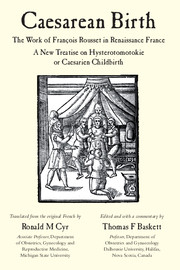 Caesarean Birth
Caesarean Birth Book contents
- Frontmatter
- Contents
- Acknowledgements
- Preface
- Translator's introduction
- François Rousset and the first text on caesarean section: a commentary by Thomas F Baskett
- A New Treatise on Hysterotomotokie or Caesarien Childbirth
- Sonnet
- Dedication
- Preface to the reader
- Part 1 Definition of caesarean childbirth
- Part 2 Second proof: logic (reason)
- Part 3 Third justification: expert opinion
- Part 4 Examples documenting other worse dangers from similar operations that are not caesarean
- Part 5 Other more popular justifications
- Part 6 On the fertility that remains after caesarean section
- A short guide to surgeons on the technique of caesarean
- Approbation
- Copyright
- Appendix 1 Summary of 16th century French history
- Appendix 2 Renée de France (1510–1575), Duchess of Ferrara, Chartres, Montargis and Nemours
- Appendix 3 Jacques de Savoie-Nemours (1531–1585), Duc de Nemours and Genevois
- Index
A short guide to surgeons on the technique of caesarean
Published online by Cambridge University Press: 05 June 2014
- Frontmatter
- Contents
- Acknowledgements
- Preface
- Translator's introduction
- François Rousset and the first text on caesarean section: a commentary by Thomas F Baskett
- A New Treatise on Hysterotomotokie or Caesarien Childbirth
- Sonnet
- Dedication
- Preface to the reader
- Part 1 Definition of caesarean childbirth
- Part 2 Second proof: logic (reason)
- Part 3 Third justification: expert opinion
- Part 4 Examples documenting other worse dangers from similar operations that are not caesarean
- Part 5 Other more popular justifications
- Part 6 On the fertility that remains after caesarean section
- A short guide to surgeons on the technique of caesarean
- Approbation
- Copyright
- Appendix 1 Summary of 16th century French history
- Appendix 2 Renée de France (1510–1575), Duchess of Ferrara, Chartres, Montargis and Nemours
- Appendix 3 Jacques de Savoie-Nemours (1531–1585), Duc de Nemours and Genevois
- Index
Summary
I believe I have fulfilled my promise, which was to provide enough evidence that caesarean section can be performed safely without fearing the slander that one life is being threatened to save another: since both lives were already in jeopardy when all hope for them was abandoned. I will thus stop here, dear surgeon, leaving to you the double task of operating and also taking responsibility for setting up detailed protocols once you have enjoyed a few successes; both being all the more your duty as you acquire experience and knowledge. This is something that many who performed the operation were lacking, although they succeeded, even if it was happily thanks to Him, from whom all happiness comes. However, to please you and to offer assistance to the first-time operator, expecting that after their first experience you will offer them better advice, as this subject surely warrants, I will in an open forum touch upon some general principles, avoiding too much detail, hoping not to imitate that perfectionist painter who, always trying to improve what was already good enough, could not take his brush off the canvas, thereby obscuring and spoiling everything.
Always first ascertain that the child cannot be delivered in a simpler way. Secondly, verify that the patient is strong and shows no signs of imminent death; more importantly, that she has not been too bruised-up by the midwives or subjected to rough and cruel attempts at extraction by some barbers – which happens more often on their part than from the matrons; otherwise blame for the patient's death would be directed at your caesarean rather than toward them.
- Type
- Chapter
- Information
- Caesarean BirthThe Work of François Rousset in Renaissance France - A New Treatise on Hysterotomotokie or Caesarian Childbirth, pp. 107 - 112Publisher: Cambridge University PressPrint publication year: 2010


